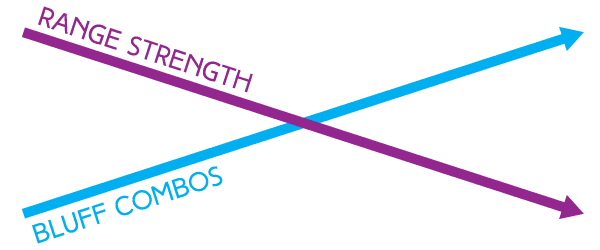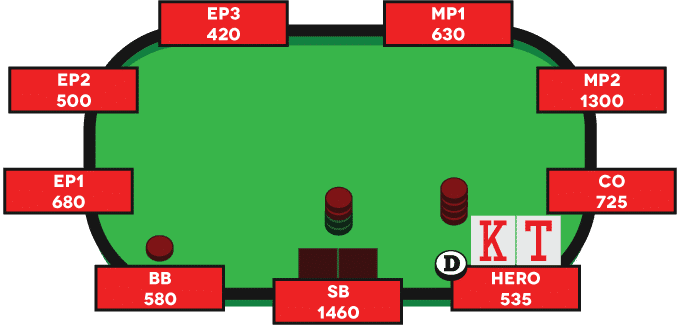By now most people have heard about range-based thinking. When you read your opponents’ hands, you are not trying to put them on a single holding. You are trying to think of all the possible hands they could hold while playing the same way. This is their hand range.
It’s equally important to consider your own hand range. How you should play hand X that you happen to hold depends on the composition of your entire hand range.
As a trivial example, consider the following scenario. It’s the river, and you have one pot-sized bet remaining in your stack. Your single opponent has checked to you, and it’s your turn to act.
The board is J♦ J♠ T♦ 9♥ 7♣. You hold 7♦ 6♦.
Should you bet? Or should you check it through?
It is impossible to answer this question intelligently without first considering your hand range. Say you have arrived at this point in the hand, and rather improbably, the only hands you can hold and play the same way are:
J-J, J-T suited, J-9 suited, T-T, and 7♦ 6♦.
Should you bet your 7♦ 6♦ in this case?
Absolutely. Why? Because all the rest of the hands in your range are nut or nearly-nut hands. Assuming you can have all combos of the listed hands, you can have quads one way, jacks-full three ways, and tens-full three ways. And there’s one combo of the 7♦ 6♦. So from your opponent’s perspective, 7/8 of the time you have nearly the nuts. Only 1/8 of the time, you have a busted hand.
Your opponent can’t call profitably—he’s likely to win only 12.5% of the time, and he needs to win at least 33% of the time to call a pot-sized river bet.
Since the rest of your range is so strong, you can bluff your busted hand with impunity. Say you could have 7♦ 5♦ as well. You could bluff that hand too, since 2/9 is still less than 33%. How about 6♦ 5♦ also? Still a bet, since 3/10 is less than 33%. But as we add weak hands to the range, we edge closer to point where bluffing is no longer the obvious play.

In general, whether to bluff with a busted hand or not depends on the strength of the rest of your range. The stronger the remainder of your range, the more inclined you should be to bet your busted hand. If your range were much weaker, however—say you could hold any busted flush draw, ace-high hands, and more—then perhaps you’d play your pair of sevens for its meager showdown value and check it.
The general point is a crucial one. How you play your hand—at all decision points—depends on where the hand you happen to hold falls within the range of hands you could possibly hold. To simplify the strategic implications of this principle, it’s frequently useful to think about your hand’s percentile. How good is this hand compared to all the hands I could hold? Is it among the best (i.e., the top of my range)? Is it among the worst (i.e., the bottom of my range)? Is it in the middle?
If your hand is a 90th percentile hand, it is among the best in your range. If it’s a 50th percentile hand, it’s right in the middle. And so forth.
I think in terms of percentiles when I make some common decisions. For example, say you open-raise K♥ T♥ preflop and your opponent 3-bets you. Should you call? Should you fold? It’s not an obvious decision in many cases. Thinking in terms of percentiles can help guide you.
Say I open K♥ T♥ from UTG in a 9-handed game. One player calls, and then the cutoff makes a pot-sized 3-bet. Everyone folds back to me. Should I call?
If I look at the entire range of hands that I am willing to open from UTG, K-T suited is among the weakest. It’s maybe a 10th, 20th, or 30th percentile hand depending on game conditions.
If I am to call the 3-bet with K-T suited, therefore, I am implicitly saying that I would call the 3-bet with nearly all my hands. Does that sound correct? In most typical cash game scenarios, against a 3-bet from the cutoff it’s clearly not correct to call with everything. So K♥ T♥ is probably a fold.
Now let’s say you open K♥ T♥ from the button, and the small blind 3-bets. Should you call this 3-bet?

If you’re opening a typical steal range from the button, K♥ T♥ is now a 70th or 80th percentile hand. If you were to fold to the 3-bet, you would be implicitly saying that you should fold nearly everything to a raise. Clearly that can’t be correct (unless your opponent is ridiculously tight with 3-bets in this scenario), so K-T suited is now a call.
The most important factor in determining whether you should defend K-T suited against a 3-bet is your opponent’s range. But if you aren’t sure about what your opponent’s range looks like, it’s useful to think about your own range. Where does K-T suited fall within the hands you can have? If it’s among the worst, it’s probably best to fold. If it’s among the best, it’s probably best to defend. If it’s smack in the middle of your range—a 50th percentile hand—it’s probably pretty close between calling and folding.
If this idea is new to you—thinking in terms of the percentile of your hand within your range—next time you play a session, write down a few significant hands. Then at home, for each decision point in the hand, write down an estimate for your hand range. Finally, determine roughly what percentile your actual holding represents within your range. Think about if the play you made makes sense for the relative strength of your hand.
Once you get used to thinking this way, you will find yourself using this percentile logic to help you make decisions while you play.

